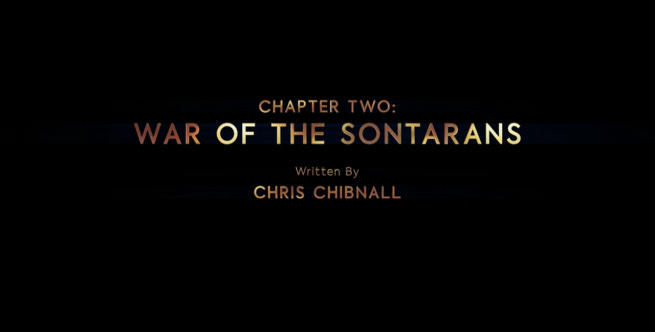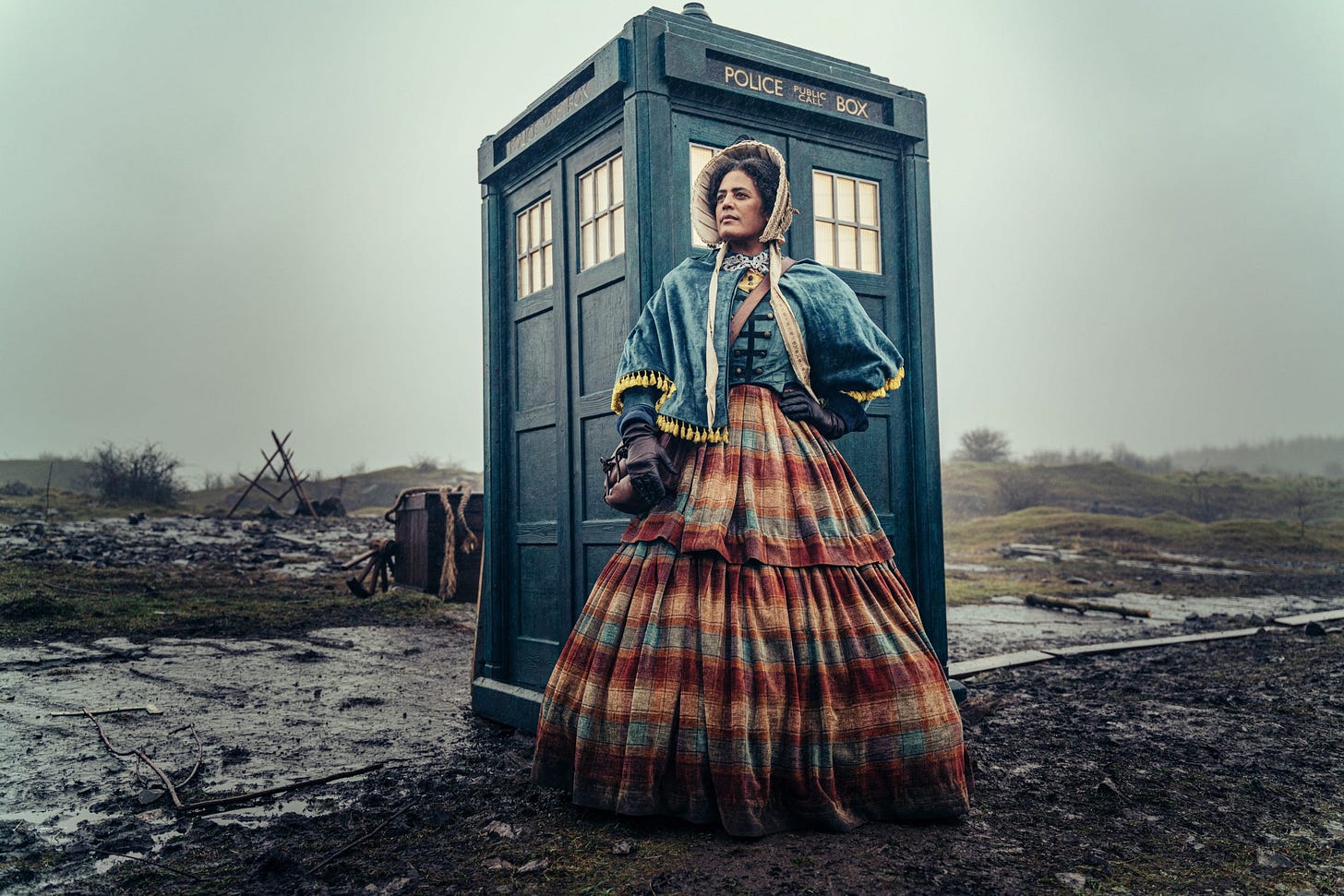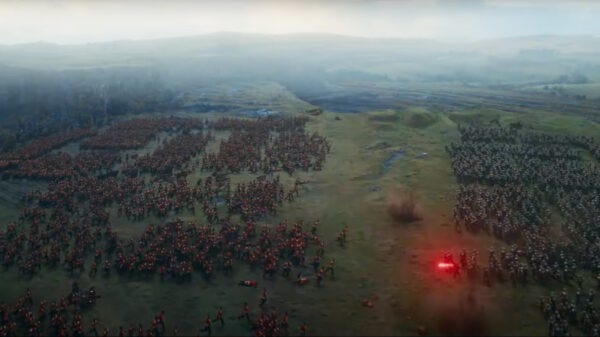Seeing Mrs. Seacole
“War of the Sontarans” raises the stakes and the excellence of Doctor Who: Flux.

Doctor Who: Flux
“Chapter Two: War of the Sontarans”
Series 13, Episode 2
Written by Chris Chibnall
Directed by Jamie Magnus Stone
Starring Jodie Whittaker, Mandip Gill, and John Bishop
Guest Starring Sara Powell, Jacob Anderson, Paul Broughton, Craige Els, Sue Jenkins, Gerald Kyd, Rochenda Sandall, Sam Spruell, Dan Starkey, and Jonathan Watson
60 minutes
Original broadcast 7 November 2021
1. Past & Present
Let me put this judgment on the record straightaway: the second episode/chapter of Doctor Who: Flux’s six installments, “War of the Sontarans,” is a cracker.
A victory.
A coup.
A triumph.
A lovely fulfillment of the faith we invested in its overstuffed-yet-enjoyable predecessor, “The Halloween Apocalypse.”
Yes, dear reader, Team TARDIS swings for the fences with this segment and knocks it for six.
Such comments should not suggest that “War of the Sontarans” is spotless, but, beyond being a step up from “The Halloween Apocalypse,” it calls to mind Series 11’s third installment, “Rosa,” in that even its imperfections demonstrate just how good Flux’s second chapter is. Overcoming these blemishes helps “War of the Sontarans” achieve a level of excellence that makes this outing one of the best historical adventures yet seen during New Who’s 16-year, 13-series tenure.
Considering how “The Halloween Apocalypse” concludes, with the Thirteenth Doctor (Jodie Whittaker), Yasmin “Yaz” Khan (Mandip Gill), and Dan Lewis (John Bishop) watching the Flux shockwave race toward the TARDIS soon after the Doctor convinces a Lupari fleet of seven-billion spacecraft to interlock themselves into a protective shield around Earth, the fact that all three protagonists find themselves alive and relatively well in “War of the Sontarans” might strike some viewers as a minor miracle (or, perhaps, an extraordinary stoke of good luck). As the Doctor comments just before the Flux collides with the TARDIS, “The end of the universe! I always wondered what it would feel like.”
The odds that Flux’s premiere episode would kill off everything and everyone were, of course, vanishingly small, but even if “The Halloween Apocalypse” had done so, showrunner Chris Chibnall would’ve found some way to undo the damage. The Flux adventure, after all, must continue in Series 13’s five remaining episodes, so, despite its pleasures, “The Halloween Apocalypse” ends on a note of false drama redeemed by Whittaker’s well-played shock and dismay, helping sell the fact that circumstances are dire for New Who’s characters even if audience members know better.
Chibnall, by constructing this planet/galaxy/universe-in-peril scenario, leans heavily into the disaster-narrative tropes that Doctor Who’s writers routinely embrace, but that viewers recognize as mere hurdles for the Doctor and her companions to vault while saving the day.
Faithful fans may well have lost count of how many times the franchise has imperiled all existence, with perhaps the purest New Who expression of this storyline being Series 4’s fabulous two-part finale (“The Stolen Earth” / “Journey’s End”), in which Dalek creator Davros’s (Julian Bleach’s) plan to detonate a Reality Bomb that will annihilate anything and everything poses a terrible challenge for David Tennant’s Tenth Doctor, one that requires the assistance of all his New Who companions—including the principal cast members of spinoffs Torchwood and The Sarah Jane Adventures—to solve.
These episodes, thanks to writer Russell T. Davies’s go-for-broke attitude, are pulse pounding, wonderfully kinetic, beautifully absurd, and deadly serious all at once. By cramming “The Halloween Apocalypse” with so much incident and doom, Chibnall aims for similar tones and outcomes in Flux’s first installment, but his choice to ram so much exposition into this premiere dilutes its quality just enough to make one hope his follow-up effort embraces a statelier pace to permit both his characters and his audience to breathe.
That Chibnall fulfills this goal in “War of the Sontarans” speaks well of his long-term plans for Flux. This installment finds the Doctor, Yaz, and Dan coming to consciousness on a battlefield that the Doctor quickly determines is located in Sevastopol, Crimea in the year 1855. Dan is properly astonished that he’s traveled back to the Crimean War after the end of the universe, leading the Doctor to conclude that time is fundamentally broken and, therefore, running wild.
She suspected as much when, during “The Halloween Apocalypse,” the TARDIS began leaking black goo while shifting its internal geometries so that doors, columns, and consoles started appearing in odd configurations, moving about the timeship’s interior and provoking its Cloister Bell to clang dolorously as a warning that catastrophe was upon them. Finding herself and her companions in the middle of 19th-Century Crimea confirms these worries, causing the Doctor to wonder, along with the rest of us, what else might go wrong.

2. The War & Mrs. Seacole
“Plenty” is the answer, although summarizing the plot of “War of the Sontarans” is far less compelling than this second installment’s chief glory: its attention to characterization. Chibnall allows his fictional people to carry Flux’s complex storyline forward rather than foregrounding the serial’s plot gyrations as mechanically as he did in “The Halloween Apocalypse,” thereby permitting this new outing’s personalities to come into distinct focus.
And of all the guest characters populating “War of the Sontarans,” none is grander than Mrs. Mary Seacole (Sara Powell), the Jamaican-born entrepreneur and nurse who funded her own voyage to Crimea during England’s 30-month-long conflict with Russia, who built a makeshift hospital and rooming house called the “British Hotel” out of scraps that she scrounged from whatever sources she could find, and who offered succor to the war’s soldiers (from all sides) as expertly as her famous counterpart, Florence Nightingale.
Except that Britain’s troops, led by the ostentatious and supercilious Lieutenant General Logan (Gerald Kyd) of the “Light Division” (yes, subtle shades of Tennyson here), do not fight soldiers from Russia, a name unknown to Logan and Mrs. Seacole. No, according to them, the Sontarans have always been on Earth, residing in what we viewers know as Russia, but which Logan’s maps identify as Sontar.
The Doctor realizes that the Sontarans, who were aware of the Flux event in “The Halloween Apocalypse” but claimed not to be its cause, slipped beneath the Lupari shield just before its seven-billion-strong ships interlocked. This move allowed the Sontarans to travel back into Earth’s history to conquer the planet, identifying the Crimean conflict as a focal point in human warfare, namely the first time that modern technology was used in the pursuit of slaughter, making this combat a perfect testing ground for the Sontarans’ battle strategies.
Longtime science-fiction readers and viewers have seen this plot—an extraterrestrial species travelling into a planet’s past to overcome its populace’s resistance by defeating them at an earlier point in their technological development—before (perhaps most prominently in the eighth Star Trek film, 1996’s First Contact, although this premise haunts H.G. Wells’s 1898 novel The War of the Worlds; Arthur C. Clarke’s first-ever short story, 1946’s “Rescue Party”; and Harry Turtledove’s 1985 short story “The Road Not Taken”), so Chibnall doesn’t break new ground in “War of the Sontarans” so much as he cultivates tilled land to produce a healthy crop. Chibnall gives his Sontaran characters more depth than expected while bringing life to a woman from Earth’s past not nearly as celebrated as she should be.
On this first score, Chibnall chooses to return the Sontarans to the lumpier, potato-like appearance they manifested in Classic Who, although they remain short-but-fierce clone warriors whose delight in battle becomes nearly perverse to watch. Jonathan Watson plays the dual roles of Sontaran Commanders Skaak and Ritskaw as arrogantly as Gerald Kyd plays Lieutenant General Logan, which proves all three characters’ downfall, while Chibnall rewards New Who’s faithful viewers with a lovely gift by casting Dan Starkey as Svild, a Sontaran grunt who’s shot in the back while reconnoitering the British lines (and whose life is saved by Mary Seacole).
Starkey, who has played many different Sontarans since his first New Who appearance in Series 4’s two-part “The Sontaran Stratagem” / “The Poison Sky” (the episodes that introduce Russell T. Davies’s sleeker, redesigned versions of these Classic Who antagonists to the revival series), is best known for his comedic portrayal of Strax, a disgraced Sontaran warrior who finds new life as an associate of the Eleventh and Twelfth Doctors (Matt Smith and Peter Capaldi) during Steven Moffat’s tenure as New Who’s showrunner.
Chibnall’s decision to hire Starkey as Svild allows the actor to show how good he is at straight drama (with just a touch of the old Strax lightness), particularly when the Doctor decides to release and follow Svild to the Sontarans’ Crimean base of operations, located behind a holographic shield that the Doctor and Mrs. Seacole easily penetrate. Svild brings what he thinks is important information about the Doctor’s presence in Crimea to Commander Skaak knowing that the disgrace of being captured and released compels his execution. Svild’s death scene is nicely played by both Starkey and Watson, making Chibnall’s more serious take on the Sontarans a welcome return to form after Moffat hollowed them out as little more than fun foils for the Doctor and his companions.
Chibnall’s second chief victory in “War of the Sontarans” is the game and glorious Mary Seacole, who makes this installment soar thanks to Chibnall’s good writing but, especially, to Sara Powell’s brilliant performance. Chibnall, starting with Series 11’s “Rosa,” has made a point of spotlighting historical women who should be better known (or better understood) than they are, providing viewers with a tremendous bounty in Series 12 by including Noor Inayat Khan (Aurora Marion) and Ada Lovelace (Sylvie Briggs) in its two-part “Spyfall” premiere and by giving Mary Wollstonecraft Godwin (Lili Miller)—better known as Mary Shelley, author of Frankenstein—a major role in Series 12’s “The Haunting of Villa Diodati.”
Seacole may be Chibnall’s greatest contribution to this trend, presenting a character full of fire, compassion, and intelligence that gives Powell a marvelous canvas upon which to paint Mary’s nuances. Mrs. Seacole proves herself capable of putting Lieutenant General Logan in his place, of keeping pace with the Doctor’s intellectual nimbleness, of manifesting empathy even for so dyspeptic a patient as Svild, of surveilling the Sontarans so closely that she determines the short time interval (7.5 minutes every 27 hours) that they all return to their ships for replenishment, and of helping the Doctor and Logan stop said replenishment to force the Sontarans to withdraw entirely from the Crimean conflict.
Mrs. Seacole offers viewers a master class in writing and performing a guest character so substantial that she feels like an old friend (despite only being onscreen for thirty-or-so minutes). As happy an accomplishment as Seacole’s presence is, Chibnall balances every element in “War of the Sontarans” during its one-hour running time, which elapses more quickly than the shorter “Halloween Apocalypse” even as this episode gives Yaz and Dan, who disappear from Crimea thanks to the Flux’s strange aftereffects, important quests of their own.
Dan, for instance, finds himself back in 2021 Liverpool two days after departing with the Doctor, only to encounter his parents—Eileen and Neville Lewis, delightfully played by Sue Jenkins and Paul Broughton—skulking around the docks while keeping an eye on the Sontarans, who’ve taken control of Earth and begun constructing a fleet of timeships to invade the planet’s past.

3. Present & Future
Dan manages to contact the Doctor in 19th-Century Crimea, which allows them to purse parallel plans to disable the Sontarans’ temporal navy with the welcome assistance of Craige Els’s droll Lupari warrior Karvanista, who comes to Dan’s rescue just when matters turn grim. Yaz, on the other hand, finds herself in the mysterious Temple of Atropos, located on a planet named Time, where Jacob Anderson’s Inston-Vee Vinder has arrived after fleeing Observation Outpost Rose in “The Halloween Apocalypse.” They encounter floating-and-talking objects known as Priest Triangles that beg them to repair the temple’s inhabitants, known only as the Mouri: six humanoid women who supposedly regulate the flow of time to keep it from uncontrollably mixing the past, the present, and the future.
Yaz, now an accomplished traveller in space and time, helps Vinder get his bearings, with Mandip Gill playing Yaz’s curiosity and willingness to take chances as expertly as she plays the character’s dawning worry when siblings Azure (Rochenda Sandall) and Swarm (Sam Spruell) appear with a third entity, known only as Passenger (Jonny Mather), to destroy the Mouri and untether time from all restraint. Azure and Swarm, who know intimate details about Yaz’s and Vinder’s lives, reveal that they have visited the temple before, thereby confirming that they know the Doctor from her work with Division (even if the Doctor still cannot remember this part of her life).
Chibnall here exposes further facets of his Timeless Child narrative that, one trusts, will come to fruition in future installments. After stopping the Sontaran plot to invade Earth’s past, the Doctor and Dan arrive at the temple, which the Doctor says—despite all evidence to the contrary—should not exist because no planet called Time exists.
Chibnall wraps up the Sontaran arc by having Lieutenant General Logan use massive gunpowder kegs to destroy all the Sontaran ships in Crimea despite Commander Skaak ordering a full withdrawal, provoking the Doctor’s wrath in much the same way that British Prime Minister Harriet Jones’s (Penelope Wilton’s) decision to annihilate the Sycorax mothership (after this invading species agrees to retreat) near the conclusion of David Tennant’s first full New Who episode, 2005’s “The Christmas Invasion,” rouses the Tenth Doctor’s fury. This welcome callback to Russell T. Davies’s era of Doctor Who harmonizes with the many references to Steven Moffat’s era laced throughout Flux’s first two chapters to prove that Chibnall respects both his predecessors’ work despite not being afraid to blaze his own trails forward.
This confidence is perhaps Flux’s single best quality, since Chibnall explores the Timeless Child backstory in even greater detail here to refute (or, at least, to ignore) well-publicized criticisms of this plotline by some vocal Whovians. The Yaz/Vinder/ Azure/Swarm/Mouri story arc seems poised to form the focus of Series 13’s third chapter, “Once, Upon Time,” so I hope that Chibnall keeps his winning streak going there. The cast’s and production crew’s admirable efforts in “War of the Sontarans”—including composer Segun Akinola’s music, which seamlessly yokes snare-drum military cadences to beautiful, lyrical melodies—deserve a serial that rewards their hard work and good faith.
“War of the Sontarans” repays them as well as any outing of the Chibnall era yet has, so I look forward to seeing Chapters Three, Four, Five, and Six. What else is left to say about this victorious entry in Flux’s ongoing storyline?
Oh yes, only this: Sontar-ha!




